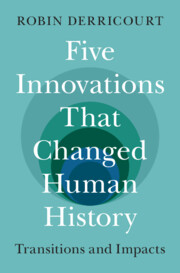Refine search
Actions for selected content:
5 results
Chapter 5 - Dedicated Inventions
- from Part II - Technologies and Ritual Experience
-
- Book:
- Technologies of the Marvellous in Ancient Greek Religion
- Published online:
- 04 September 2025
- Print publication:
- 24 July 2025, pp 125-184
-
- Chapter
-
- You have access
- Open access
- HTML
- Export citation
LONGEST CYCLES AND LONGEST CHORDLESS CYCLES IN
 $2$-CONNECTED GRAPHS
$2$-CONNECTED GRAPHS
- Part of
-
- Journal:
- Bulletin of the Australian Mathematical Society / Volume 112 / Issue 3 / December 2025
- Published online by Cambridge University Press:
- 27 February 2025, pp. 401-409
- Print publication:
- December 2025
-
- Article
- Export citation
Chapter 3 - Domesticating Horses
-
- Book:
- Five Innovations That Changed Human History
- Published online:
- 01 November 2024
- Print publication:
- 21 November 2024, pp 44-88
-
- Chapter
- Export citation

Five Innovations That Changed Human History
- Transitions and Impacts
-
- Published online:
- 01 November 2024
- Print publication:
- 21 November 2024
THE COMPONENT NUMBER OF LINKS FROM GRAPHS
-
- Journal:
- Proceedings of the Edinburgh Mathematical Society / Volume 45 / Issue 3 / October 2002
- Published online by Cambridge University Press:
- 14 October 2002, pp. 723-730
-
- Article
-
- You have access
- Export citation










